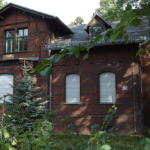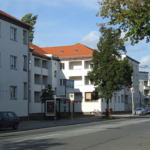TREPTOW-KÖPENICK: INDUSTRY, NATURAL BEAUTY
AND TRANQUILITY IN THE CITY
Though Treptow and Köpenick officially merged as part of a city-wide administrative reform in 2001, the districts remain distinct in terms of topography and lifestyle.
If Treptow is up-and-coming, thanks to its growing industrial and technological infrastructure, Köpenick - where forests, lakes, parks, and nature preserves make up approximately 70% of the area - is known for its village-like calm.
Glienicker Weg in Adlershof by Exxu (own work) Public Domain; Wassermannstrasse in Adlershof by Exxu (own work) Public Domain; New Venice (Neu-Venedig) settlement in Berlin-Rahnsdorf 2 by A. Savin (own work) CC BY-SA 3.0;
Divided into 15 localities, Treptow-Köpenick showcases an array of architectural styles and picturesque landscapes, along with the lowest population density in Berlin. Because of the high number of school closures in Treptow, its residents include a large percentage of senior citizens, though the Wissenschafts- und Wirtschaftsstadt technology park in Adlershof is drawing new skilled workers and students to the area. Lower-than-average rents also attract a number of artists to Treptow, though the creative scene here is more underground than in districts like Wedding and Neukölln.
In the area of Treptow north of the Teltow Canal, period villas and apartment buildings predominate. South of the Teltow Canal, in Altglienicke and Bohnsdorf, is a mix of single-family homes and modern and early 20th-century row houses; a small section of the future Berlin-Brandenburg airport is located in Bohnsdorf. The Garden City of Falkendorf, a UNESCO World Heritage site in Bohnsdorf, is a collection of century-old single-family homes with generous green spaces. Plänterwald and Baumschulenweg are the greenest, most peaceful neighborhoods in Treptow, while growing numbers of young people are moving to Alt-Treptow, thanks to its low cost of living and its proximity to trendy clubs and bars in Kreuzberg and Neukölln. Niederschöneweide is a former industrial area that’s still in transition - housing in simple old buildings (one-time workers’ tenements) is particularly inexpensive here.
In Köpenick, single-family homes make up the majority of the living space, along with well-preserved apartment buildings from the 19th and 20th centuries. East of Köpenick’s old town is Kietzer Vorstadt, a former fishing village with restored one-story houses with saddle roofs. The so-called Märchenviertel in Köpenick-Nord has single-family homes with gardens. The Köllnian suburb west of old town Köpenick is characterized by industrial areas and modern residential buildings from the 1970s and 1980s. Friedrichshagen is a former mansion colony where many artists live in sophisticated late 19th-century buildings and villas. The one-time fishing village of Rahnsdorf is now home to Neu-Venedig (New Venice), an idyllic settlement of islands, bridges, and canals with villas, weekend cottages, and single-family homes -- some of which can only be reached by boat.
The districts of Müggelheim, Schmöckwitz and Grünau combine single-family homes with farm houses and open space -- seclusion and tranquility are the key words here, at least until the Berlin-Brandenburg airport opens. There are new housing developments in Grünau-Ost and An der Regattastrecke, including the Puerto Verde quarter, which features canal-side row houses, apartment buildings with docks, a waterfront promenade, and a yacht harbor. Oberschöneweide is transforming into an industrial and cultural hub, thanks to the recently upgraded Elektroindustrie-Zentrum Oberschöneweide and the new Hochschule für Technik und Wirtschaft (Technical and Business College), which is bringing an increasing number of students to the area.
The most heavily-trafficked streets in Köpenick are Adlergestell/Wernsdorfer Straße, Oberspreestraße/ Müggelheimer Damm, Müggelseedamm, and Fürstenwalder Allee. Dörpfeldstraße, Schnellerstraße/Oberspreestraße, Baumschulenstraße, Schönefelder Chaussee, and Waltersdorfer Straße are the busiest boulevards in Treptow.
Treptow-Köpenick has both mainstream and off-the-beaten path shopping options. There are three large-scale malls, all located at or near S-Bahn stations: the Forum am S-Bahnhof Köpenick, Park Center Treptow, and Zentrum Schöneweide. Flea market enthusiasts frequent the Kunst- und Trödelmarkt at the Friedrichshagen S-Bahn station. In Altstadt Köpenick (the old city of Köpenick) and on Bölschestraße in Friedrichshagen, upscale boutiques, charming cafes, and specialty stores draw discerning shoppers from all over the city.
Both Treptow and Köpenick are ideal for nature lovers: the Köpenick Forest is the largest forest area in Berlin, Müggelsee is the city’s biggest lake (and a haven for sunbathers, sailors, and fans of watersports), and the hiker-friendly Müggel Mountains are home to the highest point in the capital. Along the banks of the River Spree, Treptow Park boasts beautiful meadows and picnic areas along with largest Soviet memorial in western Europe, the Archenhold Observatory (with the world's biggest refracting telescope), and a scenic harbor with passenger ships offering boat tours. The lakeside promenade Am Müggelsee is a beloved walking and cycling trail.
Arena Treptow is a hip location for concerts, festivals, and theater, while Schlossplatztheater and Stadttheater Cöpenick also put on regular performances. The Köpenicker Musikkneipenfest (Pub Music Festival) and the Blues and Jazz Festival rank among the most well-regarded music events in the city. The home field of the Union-Berlin soccer club, the Alte Försterei stadium doubles as a popular venue for large-scale community events. The Wuhlheide outdoor amphitheater hosts major music concerts by local and international artists, while the FEZ center for children in Wuhlheide is the biggest non-profit amusement park in Europe.
Though gastronomy isn’t one of the district’s strong points, there are a handful of above-average restaurants and cafes, including the Treptower Klause in Alt-Treptow, where they serve modern German cuisine with a Mediterranean twist. Locals favor classic cafes like Behring in Baumschulenweg, Mokkafee in Altstadt Köpenick, and Espressobar LaLü in Oberschöneweide. The lakeside beer garden at the Berliner Bürgerbräu on Müggelsee is a popular place to spend a summer afternoon.
Treptow has a decent public transportation infrastructure with a number of S-Bahn and bus connections. There are S-Bahn lines in Köpenick, as well as tram and bus lines, though it’s easier to get several around in some of the more far-flung areas of the district if you have a car. Keep in mind that Köpenick is near the soon-to-open Berlin-Brandenburg International airport, so noise pollution could be an issue in the future.
Treptow has a decent public transportation infrastructure with a number of S-Bahn and bus connections. There are S-Bahn lines in Köpenick, as well as tram and bus lines, though it’s easier to get several around in some of the more far-flung areas of the district if you have a car. Keep in mind that Köpenick is near the soon-to-open Berlin-Brandenburg International airport, so noise pollution could be an issue in the future.
Average rental price per m2
8,30 EUR
Building style ratio
Apartments: 81%, Houses: 19%
Population
21% Families, 6% Couples, 8% Singles
Photos (left to right): Lohmühlenplatz on the Alt-Treptow/Neukoelln border by Lotse (own work) CC BY-SA 3.0; Ernstraße in Baumschulweg by Harald Rossa (assumed based on copyright claims; no machine readable source) CC BY-SA 2.5; Hundsfelder/Pitschener Straße in Bohnsdorf by Berfels (own work) CC BY 2.0; Falkenberg Garden City settlement in Bohnsdorf by Guido U. Draheim (own work) CC BY-SA 3.0; Bölschestraße-Aßmannstraße in Friedrichshagen by Taxiarchos228 (own work, 04.05.13) Free Art License; Ahornallee in Friedrichshagen by Kvikk (own work) CC BY-SA 3.0; Salvador Allende quarter in Koepenick - view from Müggelturm by Andreas Steinhoff (own work) (Attribution - use for any purpose, provided that the copyright holder is properly attributed); Mentzelstraße (formerly Spindler company housing) in Koepenick by Andreas Steinhoff (own work) (Attribution - use for any purpose, provided that the copyright holder is properly attributed); Edisonstraße in Oberschöneweide by Rolf Krahl (own work) CC BY 4.0; Roedernstraße in Oberschöneweide by Rolf Krahl (own work) CC BY 4.0; Fennstraße in Niederschöneweide by Lotse (own work) CC BY-SA 3.0; Moosstraße in Niederschöneweide by Lotse (own work) CC BY-SA 3.0; Am Seddinsee in Schmöckwitz by Orderinchaos (own work) CC BY-SA 4.0; Alt-Schmöckwitz by Sinuhe20 (own work) CC BY-SA 3.0; Dammweg Bridge in Plänterwald by Lienhard Schulz (own work) CC BY-SA 3.0; New Venice (Neu-Venedig) settlement in Berlin-Rahnsdorf by A. Savin (own work) CC BY-SA 3.0; Eichenstraße in Alt-Treptow by Zael (own work) CC BY-SA 3.0


















